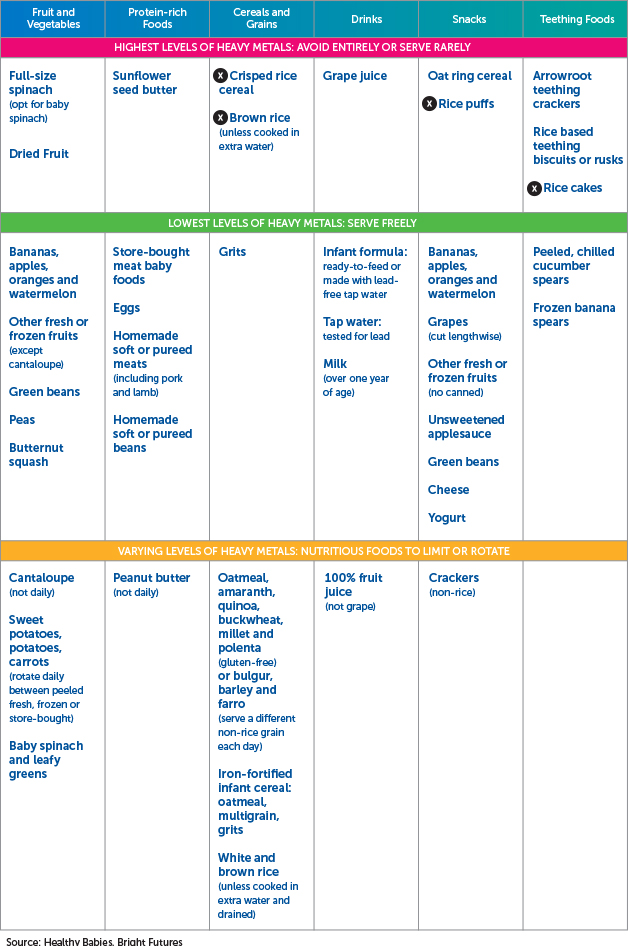Heavy metals and their effect on our bodies has been an increasingly popular topic, especially when it concerns the health of some of the youngest and most vulnerable in our society.
So, a recent follow-up to a 2019 study has created a moment of pause as it reveals that baby food, whether store bought or homemade, has alarming levels of heavy metal contamination.
To add insult to injury, the study goes on to say that exposure goes far beyond just foods geared toward babies and young children, finding heavy metals in foods that many of us eat day to day.
While our bodies do need smalls amounts of some heavy metals in order to function properly, such as zinc, copper, chromium, iron and manganese, exposure to large amounts, especially those flagged by the World Health Organization as “chemicals of public health concern,” has been linked to serious, long-term health effects.
What does this mean for the health of your family? We spoke with Chris McGonnell, M.D., a pediatrician and physician on the medical staff at Texas Health Frisco, and at Forest Lane Pediatrics, to learn more about what exactly heavy metals are, what risks they could possibly pose, and how to best avoid exposure as much as you possibly or reasonably can.
The Study
The study, performed and funded by Healthy Babies, Bright Futures (HBBF), tested if making your baby’s food at home allowed for a lower risk of heavy metal exposure versus store-bought or manufactured foods. According to the American Academy of Pediatrics (AAP), toxic metal exposure can be harmful to the developing brain. It's also been linked with problems with learning, cognition, and behavior. The metals they most closely focused on were lead, arsenic, mercury and cadmium.
HBBF tested 288 foods and examined 7,000+ additional food testing data from published studies and found no evidence to suggest that homemade baby food has lower heavy metal levels than store-bought brands. They also found that heavy metal levels varied widely by the type of food, not by who made the food.
Results showed 94% of all food samples (store-bought or homemade) contained detectable amounts of toxic heavy metals.
What This Means for Parents
It’s natural to read a study like this and immediately feel concerned, especially when it seems like there’s no guaranteed way to avoid exposure. While McGonnell notes studies like this are important reminders that these things are out there and we should be mindful of them, they shouldn’t cause you to immediately enter panic mode.
“I think what we’re learning is that it has less to do with how the item is prepared or grown and more of a fact that these metals are just here despite our best efforts,” McGonnell says. “It may ease your worries though to know I don’t see a lot of kids with severe cases of toxicity. Occasionally, we’ll see a child with lead poisoning, but usually it’s from non-food related means.”
Lead is one of the biggest environmental threats to young children, and the only heavy metal that the AAP and the Centers for Disease Prevention and Control (CDC) currently recommend parents screen their children for exposure. There are often no apparent symptoms when a child is exposed to lead, which is why many health care providers include the screening in annual 1- and 2-year-old well-child checkups. The test is typically done with a small blood sample taken from a simple finger prick.
While McGonnell notes most children are exposed due to lead mainly in their physical environment, especially if your home was built prior to 1978 (when lead-based paints were banned), have older water pipes, or have antique items in the home, lead can also find its way into your child’s body through underregulated toys, jewelry, and, sometimes, food.
“Some countries have looser restrictions and less regulation around lead-based products. Even if you never travel abroad, just because of the nature of how global our economy is, items from those countries can still find their way into your home and on your dinner table,” he explains. “We recently did see a child where the source of the lead was coming from some spices the family had purchased from overseas from a country with less regulation.”
While there is no known “safe” level of lead exposure in children, a level of 5 mcg/dL or more is used to indicate a possibly unsafe level for children.
“Here in Frisco, we don’t see too many cases just because the homes are a bit newer, but as you head into cities like Dallas with older homes and buildings, or more rural areas, that’s when we tend to see some more cases pop up,” McGonnell adds. “But, once again, this study goes to show that it’s there in our food too, adding another layer of exposure.”
This study might push you to switch your family over to all-organic to help combat exposure, but the report found buying organic didn't lower heavy metal levels either due to the source of the exposure coming mostly from the soil and water used.
You may then consider starting up your own garden at home, but unless it’s something you really feel compelled to do — maybe you have a green thumb, want to save a bit of money on commonly used produce, or want it to be a fun, educational activity for the family — McGonnell says it may be more trouble than it’s worth.
“I know there are some local places, such as Texas A&M, where you can bring your soil for testing. However, you can spend a lot of time and energy trying to find the perfect soil, but then you’d have to produce enough of it and have enough space to accommodate your family’s agricultural needs, and that would be incredibly difficult, if not impossible for most people,” he explains.
Something McGonnell says is a lot more manageable for most families is keeping up with child’s wellness visits, focusing on well-balanced meals and physical activity, and just enjoying your time with your kiddos.
“From the other side of the fence where I see kids every single day, we’re more intent on screening kids for any kind of developmental disorders, tracking their growth and milestones, and paying attention to their upbringing,” McGonnell says. “Families are already stressed when it comes to giving their child healthy foods they’ll actually eat. So I don’t want families to read this study and become super anxious about what they’re going to feed their kids. I rather kiddos eat more vegetables than less of them.”
What You Can Do
The best way to limit your baby’s, and your family’s, exposure, may be less about avoidance and more about diversity when it comes to the foods you consume.
The study identified the most contaminated foods as well as the least contaminated foods to help you make more informed decisions on what to feed your family. However, they did note four foods in which they suggest completely avoiding due to high levels of contamination with heavy metals: crisped rice cereal (such as Rice Krispies®), traditionally cooked brown rice, rice-based puffs (such as Gerber® Puffs), and rice cakes.

If your family loves rice, and you want to keep incorporating it into your meals, HBBF does note that you can lower your risk of exposure by switching over to basmati rice, which is typically lower in arsenic, and looking for rice grown in California, India and Pakistan, as well as sushi rice from the US. You can also cook your rice in more water than you typically would, similar to cooking pasta, then draining off the excess water after cooked.
It is also suggested that you rotate rice out with other grains so that you’re not consuming it every day or multiple times a day.
Beyond that, the most important step you can take is introducing and serving a wide variety of healthy foods, whether baby food brands or homemade foods. A varied diet can help avoid elevated exposure to one or more heavy metals versus eating the same foods every day. This also ensures a healthy mix of nutrients as well.
If you are still breastfeeding, McGonnell that breastfeeding can also be helpful due to the natural filtration process that takes place when nursing.
“It’s not going to catch everything, but it’s going to do a pretty good job. While formula hasn’t had the greatest reputation as of late, if you’re formula feeding, make sure it’s coming from a reputable supplier,” he adds. “Then, just live your life. Don’t stress. Enjoy your baby, enjoy your children, and spend time with them. Don’t allow yourself to get stressed over if this food or that food is the best or the worst. Just make practical decisions for you and your family.”
The Takeaway
While this study may be startling and concerning, there is only so much that consumers can do at the dinner table to control the situation. For the time being, the best you can do is to be informed and aware, and provide varied-healthy meals for your family.
“I want to reassure parents that despite this study, we’re just not seeing toxicity and delays directly related to what children are consuming on a day-by-day basis,” McGonnell adds. “I think a lot of parents are really burned out right now and I don’t want anyone coming across this study to just become completely overwhelmed. There are times when you need to take things a little more seriously, but with this, all you can do is acknowledge that it’s a known risk and do the best you can to lower your family’s exposure. Beyond that, enjoy your time with your kiddos.”

